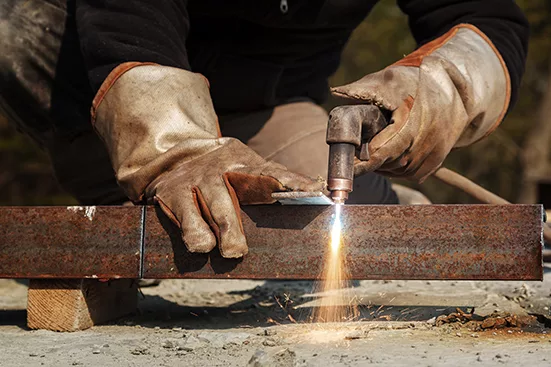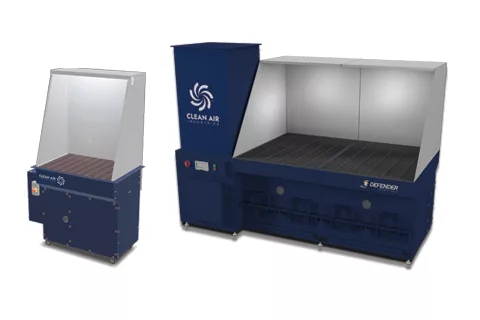Plasma Cutting
What is Plasma Cutting?
 Plasma cutting is a thermal cutting process that utilizes a high-velocity jet of ionized gas, known as plasma, to melt and remove material from a workpiece. The basic principle involves passing an electrical arc through a gas (typically compressed air) to create plasma. The plasma, reaching temperatures of up to 30,000 degrees Fahrenheit, rapidly heats and melts the material being cut, while a high-velocity stream of gas blows away the molten metal, creating a cut.
Plasma cutting is a thermal cutting process that utilizes a high-velocity jet of ionized gas, known as plasma, to melt and remove material from a workpiece. The basic principle involves passing an electrical arc through a gas (typically compressed air) to create plasma. The plasma, reaching temperatures of up to 30,000 degrees Fahrenheit, rapidly heats and melts the material being cut, while a high-velocity stream of gas blows away the molten metal, creating a cut.
Plasma cutting is widely used in various industries, including manufacturing, metal fabrication, automotive, and construction. It is primarily employed to cut through electrically conductive materials such as steel, aluminum, stainless steel, copper, and brass. It provides a precise and efficient method for cutting intricate shapes and thick metal sections.
Impact on Indoor Air Quality
Regarding air quality impacts within a manufacturing facility, plasma cutting can generate emissions and pollutants. The primary concerns are related to the release of metal fumes, dust, and gases. The specific air quality impacts depend on factors such as the type of material being cut, the cutting process parameters, and the control measures in place. Here are some key considerations:
- Metal Fumes: Plasma cutting produces metal fumes, which consist of fine particles generated when the metal vaporizes. These fumes can contain hazardous substances such as chromium, nickel, manganese, and other elements present in the material being cut. Inhalation of these fumes may pose health risks to workers if not properly controlled.
- Dust: Plasma cutting can also generate dust, especially when cutting painted or coated materials. The dust particles can contain various compounds, including pigments, binders, and other additives present in the coating. These particles can be harmful if inhaled, particularly when they contain toxic substances like lead or cadmium.
- Gases: While compressed air is commonly used as the plasma gas, other gases like nitrogen or oxygen may be employed for specific applications. The use of alternative gases can affect the composition of the emissions. Nitrogen can produce oxides of nitrogen (NOx) when exposed to high temperatures, while oxygen can contribute to increased oxidation and the formation of metal oxides.
What You Can Do
To mitigate the air quality impacts of plasma cutting within a manufacturing facility, several measures can be taken:
- Local Exhaust Ventilation (LEV): Implementing LEV systems to capture and remove the generated fumes and dust at the source can significantly reduce worker exposure. These systems typically employ hoods or enclosures near the cutting area and use filters or collection devices to trap the contaminants.
- Personal Protective Equipment (PPE): Workers should be provided with appropriate respiratory protection, such as respirators with filters specifically designed to remove metal fumes and dust particles. Other PPE, like safety glasses and protective clothing, can also help minimize exposure.
- Adequate Ventilation: Ensuring proper ventilation in the facility can help dilute and remove the airborne contaminants. This may involve the use of general ventilation systems, such as exhaust fans or air exchange systems.
- Regular Maintenance: Regular maintenance of plasma cutting equipment, including cleaning or replacing filters, can help optimize its performance and minimize emissions.
- Work Practices: Encouraging good work practices, such as positioning the cutting equipment away from other workstations or sensitive areas, can help reduce exposure to emissions.
By implementing appropriate control measures, monitoring air quality, and providing training and awareness to workers, the potential air quality impacts of plasma cutting can be effectively managed within a manufacturing facility.
Clean Air Solutions for Plasma Cutting

Industrial Dust Collectors
Up to 65,000 CFM Airflow
Ruggedly designed for heavy-duty use, providing effective solutions for centralized fume and dust collection.
Learn More
Downdraft Tables
Up to 9,000 CFM Airflow
Discover portable and industrial downdraft tables available in multiple configurations with best in-class performance.
Learn More
Environmental Booths
Welding & Grinding
Durable and reliable, environmental booths are a self-contained, highly-customizable solution for welding, grinding, and more.
Learn More